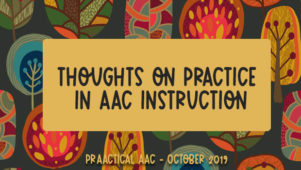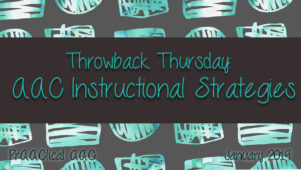PrAACtical Thoughts on Supporting Reluctant Communicators

As any experienced AAC professional will tell you, people who are learning to use AAC systems don’t produce as much verbal output as their speaking peers. And, every once in awhile, we run into an AAC learner who communicates VERY infrequently even though they are capable of doing more. They’re often described as shy (perhaps) or stubborn (cringe! shudder! clench teeth!), but, in our view, their reluctance to communicate is probably related to a few other things. We generally don’t like to do things that are difficult for us, particularly if the pay-off is not in proportion to the effort, or if there are insufficient supports. If the learner has had a history of being unsuccessful or associates communication with a high level of effort, it makes sense that they are not rushing to interact with us.
It doesn’t always pay to rush things. Sometimes we get better outcomes by building trust first, then moving onto self-confidence and verbal expression as the relationship develops. Here are some other thoughts on ways to positively impact the learning of reluctant communicators.
1. Treat them as if they are capable of responding but choose not to (for whatever reason). Honor that. We all prefer to be around people who respect our choices, right?
2. Reduce or eliminate confrontation. Putting them on the spot is not the answer. In fact, setting up situations where they are obliged to respond may increase their reluctance to communicate. Avoid lots of direct questions and mentor others to do the same. As we’ve mentioned before, when we go into ‘quiz mode,’ learners like this often get defensive and shut down.
3. Let them lead. A learner-driven approach, in which we observe what they are doing and then join in is a good way to start. Intervene slowly, watching closely for signs of acceptance. Gradually insert yourself into their play, narrating as you go.
4. Have frequent, no-demand interactions. Comment on what is going on, give positive feedback on what you observed, offer them something fun, but don’t expect or prompt a response. The goal here is just to get them to see that communicating with you doesn’t mean ‘work.’
5. Use aided language input. If they’re not getting experience with language output, at least we can make it meaningful by providing competent models of AAC.
6. Broadcast their successes. Sometimes it can help to make a bit of a fuss, so try commenting on something positive that the learner did when they are in earshot. “Mr. E., did you see Jayson finish that puzzle? I didn’t know he could do it that fast!”
Kids don’t usually behave randomly, so if they are hesitant to communicate, there is probably a good reason for it. We try to develop a working hypothesis for why the communicator is not attempting to interact, then experiment with some solutions that make sense for that situation. If you have thoughts about this kind of communicator, please share them. We’re always looking for new perspectives. Maybe you have an idea that will help the rest of us.
Filed under: PrAACtical Thinking
Tagged With: AAC intervention, intervention strategies, reluctant communicator, self-confidence, trust
This post was written by Carole Zangari





8 Comments
Thank you for this post Carole. My 17 yo son has physical and cognitive challenges and I think you’re right, it’s just too much work for him to communicate using his dynamic display device. He uses it at school but refuses at home. He completely understands what’s be asked of him and prefers to answer yes-no and make simple choices, so we go with that at home. While his priority at school is still about learning academics, frankly, as his caregiver, I am getting more concerned about his ability to communicate with his caregivers and socially. Wondering if using visual scenes-based app (such as Go Talk Now or Autismate) to create home communication opportunities would be more motivating to him. Do you think switching AAC devices is a strategy that works or confuses reluctant communicators? Thanks, Randi
Randi, thanks for stopping by to comment. This is a common situation, but a tough one! It takes a lot of work for some AAC learners to get good enough with their SGDs so that it is not as effortful, and finding ways to get them to do enough practice so that SGD use becomes easier can be quite a challenge. In my experience, changing to a new device doesn’t seem to help with this issue, unless the device was not a good fit in the first place. We’ve had better luck redoubling our efforts with the intervention, adding more practice, and boosting the fun factor to get them to the point where they are more fluent. Almost all of the dynamic screen SGDs can do visual scenes, so you can try creating a few of those and see how it goes. Another option is to add a no-tech piece, like partner-assisted scanning, so that the motor component is not as big a part of the equation. Of course, every situation is different but we usually find that more improvement comes from more therapy/practice as opposed to a change in equipment.
Interesting. Thanks for your suggestion. As a team we agreed we would continue with his Dynavox (and not introduce iPad AAC) until we run out of options. Good idea to try using visual scenes on the Dvox. Of course the screen guard gets in the way but…
Hope you had a nice Thanksgiving. Randi
Thanks for the suggestions for this difficult situation. Just wanted to share a couple of my findings from my 19yo very reluctant VOCA user, cognitively able, age appropriate level of receptive language. Physical access always been a massive barrier as she cannot direct select. Head switch user and trialling eye gaze (which she finds OK for games etc but extremely tiring for communication). It transpires that The device itself presents a barrier to interaction. It’s so big – 15″ – she can’t see above or around it. The biggest revelation is that while she has an idea of what she wants to say, she isn’t sure of the words to use. Not just about location of the vocabulary. It’s like a foreign language – she knows the words when spoken but she can’t recall them to use herself. Having just discovered “by chance” about ALS – she’s responding to this. We now need to get this embedded in her daily life – somehow!
Sooo glad that she is responding well to the aided language input. It’s such a powerful strategy and, you’re right-it’s like learning a foreign language. Exciting! Keep us posted. 🙂
Great post.
I have an adult daughter with autism. She appears low-functioning, but I feel that she gets a lot more from the environment than people would credit her with.
Her block is verbal output. She can type, read, paint (using Paint, which she learnt intuitively on her own), enjoys music.
Any idea whether there is any cutting edge technology, which can pick up her thoughts and convert to speech?
Hi, my daughter is a very reluctant communicator, she has asd, sld and sm. She can talk enough to make her needs known at home, but can’t do the same elsewhere or to anyone else. We are trying an AAC app, but she’s not motivated enough to use that either at school. It’s a really tricky situation to be in……….
This is a great post. I am a Multiple Disability specialist who works with AAC, among other things, and this is what I am always trying to tell my teams! Would it be okay with you if we reprint this article in our monthly newsletter, crediting the source, of course?